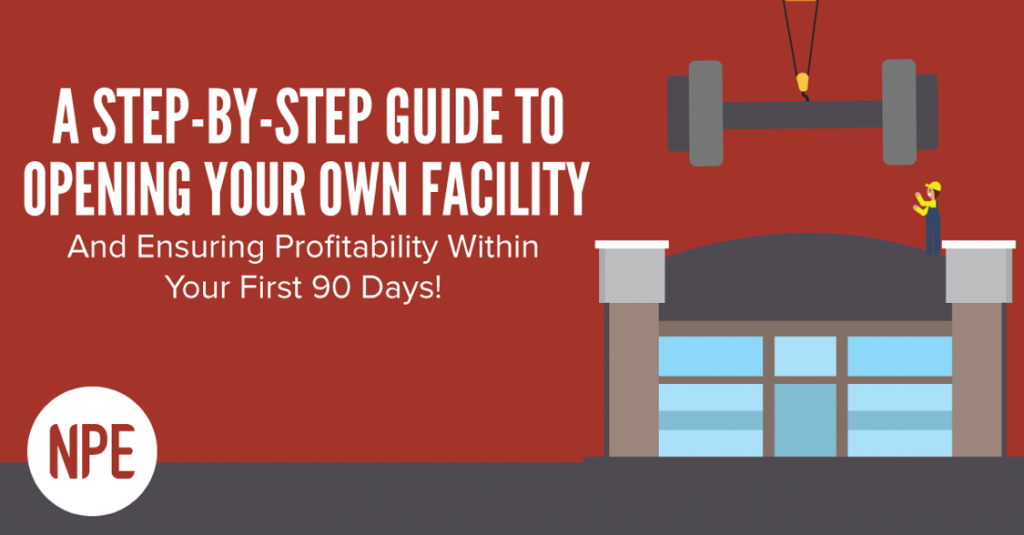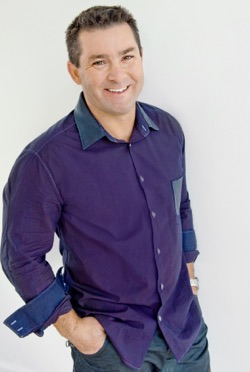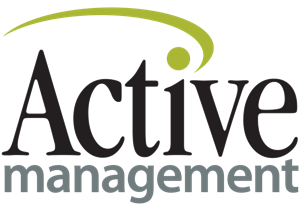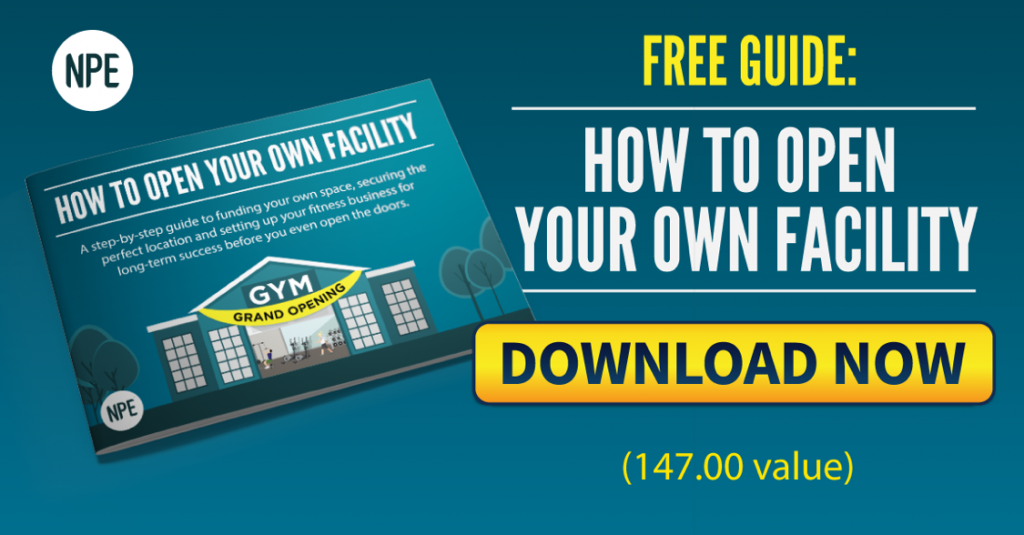From Our NPE Friends: A Step-by-Step Guide To Opening Your Own Facility (And Ensuring Profitability Within Your First 90 Days!)

By Sean Greeley, NPE CEO
Opening your own facility has a LOT of perks – you no longer have to work in someone else’s gym, which allows you to be in control of your schedule, design everything the way YOU want it to be, and be your own boss.
Most fitness professionals have a dream to open their own facility someday, but too many don’t ever move forward with that dream because they A) don’t understand the steps involved in the process and B) think they could never afford the investment.
In this article, I’m going to show you how to tackle both of those obstacles and profitably open your own facility.
Whether you’re new in the fitness industry or you’re already a business owner looking to expand and improve upon your current location, I’m going to walk you through each of the steps in opening your doors and ensuring profitability from day one.

What’s the single most important consideration when opening a new facility?
Location, location, location.
You need to put your facility in a place where you can acquire the best clients to keep it busy. Because without clients, there’s no point in having a facility at all!
Seems like common sense? The majority of fitness businesses get this dead wrong.
They look for the cheapest rent or a space they think will be cool.
But they fail to do their research and look at the data on demographics, households, age ranges, etc… which are crucial to the success of your facility.
Get this right… and you’re off to the races.
Get this wrong… and you’re in for a world of hurt on the road ahead.
When it comes to business, you can’t “create” demand for a product or service. You’ve got to find people who already want what you have to offer… and get in front of them in a way that makes it easy for them to do business with you!

Retail Units
Pros: High visibility; more likely to get foot traffic; can be more convenient for clients.
Cons: Typically more expensive for less space; fewer parking spaces; potentially have to block sound for other retail tenants which can cost more money.
Industrial Units
Pros: Often less expensive for more space; more parking spaces; typically have more flexibility for making the space your own.
Cons: Can be more inconvenient for clients depending on location; less visibility; less likely to get foot traffic.

In order to find the perfect location for your business, you need to answer one very important question:
Are your customers going to be there?
You could find what you think is the most perfect space for a facility… that you like or think is cool… but if your target market isn’t there, it’s NOT the right location for your business.
Opening your own facility is a big investment, which means it’s up to you to do research and use data – not just emotions – to make your decision.
Nail down the geographic and demographic data for an area where you’re considering opening a facility:
- How many households are in your business area?
- What’s the gender balance of that area?
- What’s the age spread in that area? (You need to know this to market effectively!)
- What’s the average household income?
- How many homes are owned compared to rented?
Once you gather that data, review it and ask yourself if your target market and potential customers are in this area.
If they are, great! But if not, keep looking and comparing other potential locations until you find the best match for your business.

A LOT of fitness professionals skip this step when they’re opening their own fitness business, but it’s one of the most important.
Take some time to envision the facility that you want – but don’t just use your perspective. Walk in your prospects’ shoes as they enter the facility for the first time.
What does the facility look like? How does it make them feel? What sounds, smells, etc. are they experiencing? What attracts them to your facility?
Remember, you are not your client. What might appeal to you might not appeal to them.
Keep this in mind as you’re looking at different spaces.

Here’s what you should have before you even start looking for a facility so you know what you’re looking for, how much you can afford, and when you’ll be able to start the process.
- A Business Plan – A formal statement of a set of business goals, the reasons they are believed to be attainable, and the plan for reaching those goals. This directs EVERY decision you make.
- Sales Forecast and Pro Forma – You’ll need structured planning using proper sales forecasting and budgeting tools (don’t just cross your fingers and hope for the best!) to understand what your business model can afford in rent or a mortgage.
- Cashflow Forecast– This gives you a snapshot of your current cash position and allows you to forecast cash balances in the future.
- Finance Options – Do your research so you can determine your strategy and options for funding the investments required in opening your facility (including the time needed to get profitable).

It’s rare that any fitness professional – or business owner – has enough cash to start up their own facility without using some sort of funding or lending. But it can be done! And we’ll talk about how to generate cash before you open your doors when we cover pre-sales and grand opening marketing.
Here are a few options that you might be able to use to open up yours:
- Credit Cards – Many people use these to start or grow their fitness business, and they can be the cheapest form of funding in many cases. Take advantage of 0% interest offers (often for 12 months) when you can.
- Microloans – These are small loans typically issued to borrowers who are low-income earners or have less-than-perfect credit and do not qualify for traditional bank financing.
- Personal Savings – This is the #1 small business financing option for most people who find that they don’t qualify for credit cards, microloans, or any other type of traditional bank financing.
- Friends & Family – Some people may have many possible investors among their friends and family (even wealthy clients) while others may not. If you do, you’ll need to convince them the business will be successful and get a return on their investment.
- Grants – A grant is a specific amount of money given to an individual or business for a specific project or purpose. You can apply for a grant from the government. You don’t need to pay the grant back, but there’s a lot of competition and they’re almost always awarded for a specific purpose or project.
- Crowd funding – This is where you ask for “pledges” or donations from others to support your cause or goal. A webpage is traditionally set up to receive donations of various set amounts in exchange for bonuses, services, etc. at different levels of giving. This also can tie into pre-sales strategies that we’ll explore later in this article.
If you don’t quality for things like business credit cards or traditional bank financing, then you may want to take the appropriate steps to correct any credit issues that may be part of the problem. Then you’ll have more options in the future as you grow your business.
Financing and establishing credit is not a one-time activity. It’s an ongoing process needing your attention from here on out as a business owner.

If you haven’t nailed down your branding yet, it’s time to do so before you open a facility.
And even if you think you’re clear on this… now is the perfect time to review your branding and ensure it’s right for your target market.
Your brand has a massive influence over your facility. You’ll be painting walls, putting up your logo, and more. Get it right now so you don’t have to waste time or money redoing it all in the future.

Creating a brand promise will create the framework for your relationship and delivery of services to clients. A brand promise is a statement that explains what you do for the people you serve that delivers what they want.
It’s a predominantly benefit-driven statement that answers the question:
“What is the primary benefit that you deliver to your clients that helps them solve their problem and/or achieve their goals?”
Here’s what you need to craft a rock-solid brand promise:
- Adjectives describing the process (ex. quickest, best, most effective, safest, etc.)
- Desired outcome from working with you
- Unique program benefits – what makes you different/special/better?

You should be able to describe everything you know about your ideal client and identify:
- WHO they are (demographics)
- WHERE they live or work (geographics)
- WHY they buy (psychographics)
Here’s an example of a solid target market:
“30 to 45-year-old men and women who are former athletes and are pissed off by watching themselves turn into the fat, out-of-shape adults they never thought they would become.”
Be sure to download our 10 Questions To Define Your Best Prospective Client for more support in identifying your target market.

One of the best ways to help distinguish your business from others is by crafting a positioning statement.
A positioning statement is an expression of how your service and brand fills a particular consumer need in a way that your competitors don’t.
It must answer the following questions:
- Who is your target market? What are the demographics, geographics, and psychographics?
- What category are you competing in? Are you competing against other gyms? Other personal trainers? Other weight loss programs?
- What primary benefits do you provide your clients? What do your clients most love about working with you, and how do they describe the benefits they value most in their own language?
- Why should they believe the claims you make about your services and how you can help them? How long has your business been around? How many clients have you served? What certifications do you and your staff hold?

For 30 to 45-year-old men and women who want to look and feel like an athlete (again), CrossFit TriTown has been recognized by our members for providing a safe and effective, high-intensity training experience in a supportive community environment through our proven programs and expert coaching staff.
Unlike traditional gyms, we focus on our members as individuals, and provide the tools, support and accountability they need to achieve sustainable results.

Whether you have a big or small space, you should map out specific zones within the facility to utilize the space well.
Ideally, the training zones should naturally extend out from the reception area. And the reception area (and control desk) should have visual control over as much of the fitness space as possible.

Fitness Spaces – This is typically the heart of the facility and includes the following components:
- Various types of equipment (depending on your training philosophy and modality)
- Stretching/warm-up/cool-down spaces
Bathrooms/Toilets and Changing Rooms – These spaces are typically separated by gender and accommodate the basic functions of changing rooms, lockers, showers, and toilets.
Administrative and Support Spaces – These staff spaces accommodate the operation and administration of the facility and include the following:
- Office
- Reception
- Storage
- Staff room

You don’t have to start out with a massive facility full of cardio and weight machines.
Many of our clients have started in a one-room facility with just a few pieces of equipment and have expanded as their business grows.
There are tons of choices when it comes to equipment, but ask yourself these questions before you make a decision:
- What equipment best serves your target market and the results they’re trying to achieve?
- Are you going to buy or lease the equipment?
- How much can you afford to spend on equipment for your facility opening?

How your facility looks has a huge effect on your clients and community.
For example, if someone walks into a gray, overcrowded space with blank walls, do you think they’re going to be pumped for a workout?
Of course not!
Try to incorporate these design tips to bring more energy into your facility (and your clients!):
- High Ceilings – These can make a small space feel larger and are scientifically proven to be better for health, improve brain connectivity, and feel more beautiful all around.
- Natural Light – Sunlit environments increase productivity and comfort. Plus utilizing natural light can help you save on energy costs.
- Color Scheme – This should be consistent with your branding and establish a sense of activity.
- Motivational Décor – Your facility should inspire and motivate your clients. Hang posters, quotes, etc. that will resonate with your target market.

Even if your facility has the perfect location, an awesome layout, and great equipment, it’s NOT ready for your clients yet.
Your clients’ safety should be of the utmost concern, and it’s your responsibility to create a space where they can work out safely and comfortably.
Here are some important considerations to give your clients a sense of security and help prevent injuries:
- Provide visual access to all potentially dangerous, unstaffed spaces
- Invest in proper impact flooring to reduce stress on joints and bones and help decrease the chance of injury from falling or running (plus, impact floors can also help absorb sound!)
- Ensure good indoor air quality, lighting, and ventilation

After you’ve invested money (and time) into your facility, one of the biggest mistakes you can make is opening your doors and just waiting for people to come.
You need to start marketing BEFORE your grand opening so you can get sales going and have cash to cover costs including rent, equipment, design, and more.
Crafting a pre-sales and grand opening marketing campaign involves four steps:
1. Identify the profile of your best client (your target market).
We’ve said it before and we’ll say it again… the MOST important component for success in business is getting very clear about WHO the profitable client is that your business will serve.
It’s nearly impossible to find the right new clients if you don’t know who they are!
2. Create a great offer and reason why to “register and learn more” about your new facility.
We’ve seen great success coaching thousands of business owners through pre-sales and grand opening marketing campaigns by creating special “founders club” offers. The offer generally includes special pricing, bonuses, and the ability to grab one of a limited number of spots available to be a “founding member” of your new facility.
Usually a big “give away” prize of free membership is also offered for one lucky person who registers and is selected.
This offer works great because when something is considered “limited” it is perceived as more valuable. And in this case it is! By being one of the first X new members to join your facility, your new client is securing a position of great value and opportunity to work with you. And locking in a membership for “founding member” rates gives them even more value by locking in a low rate now (and other bonuses) before your price goes up!
3. Get the word out by using multiple media strategies to build a list of prospective clients.
The more media you can use to get your message and offer in front of your potential client, the better.
What’s the best media you should be using? That depends on your market and local area, but here are some good ones that we’ve seen great success with:
- Direct Mail – Send postcards, letters, and/or ads to your target market.
- Flyers – Post flyers where your target market spends their time.
- Facebook Ads – You can refine your target market and send out ads to custom audiences.
- Press Releases – Announce your facility opening and raise awareness for your business.
- Networking – Attend BNI and local business gatherings; hold workshops for your target market; etc.
- Emails – If you already have a list, send out an email campaign with an incentive to join your new facility.
4. Continue marketing to that list to move them forward in the marketing process, close sales, and enroll new clients with your special offer.
The sales and marketing process never stops until you “sell out” all spots you make available!
Keep going. Continue communicating with your potential prospects, build a network of partners and key influencers in your market, and let everyone know as spots get taken. This gives great social proof that many are responding to your message and offers, and your prospects should grab a spot before they’re all gone!

Opening your own facility can give you great control over your future. You get to be your own boss and call the shots, make your own schedule, and continue growing your income.
But too many fitness professionals take the plunge without getting clear on their strategy and creating a plan to succeed.
Don’t let this happen to you… and don’t put off pursuing your dream just because you don’t know how to do it all just yet.
Learning and growing through the process is what the adventure and journey are all about!
We’ve coached thousands of fitness professionals through opening their own facility and getting profitable in 90 days… and in some cases, we’ve seen new owners completely pay off their build-out and equipment expenses through strong pre-sales and marketing campaigns!
Follow these steps to open your own facility whether you’re new in the fitness industry or you’re already a business owner looking for a better space.
Not only will you take your business to the next level… but you’ll make it easier to continue growing your business in the months and years ahead!

Justin is the Managing Director of Active Management, which he began January 2004. He offers coaching to businesses worldwide in everything from start up and design to marketing and sales systems. Justin also facilitates four Australian and New Zealand ‘fitness industry roundtables’ events, which allows him to see a huge cross section of business models.

